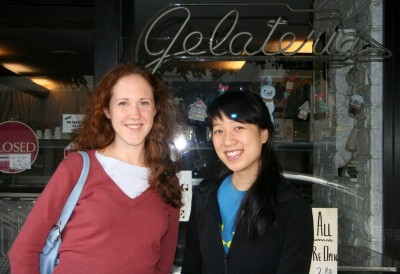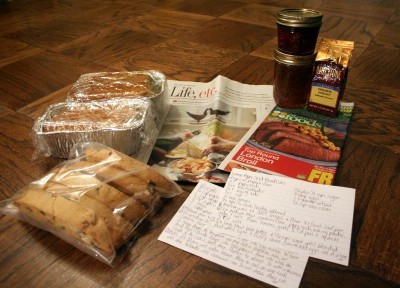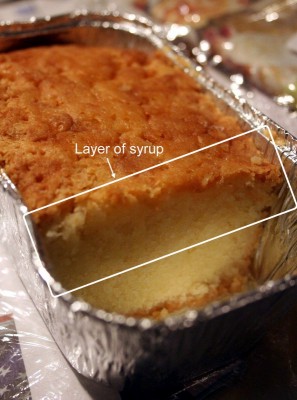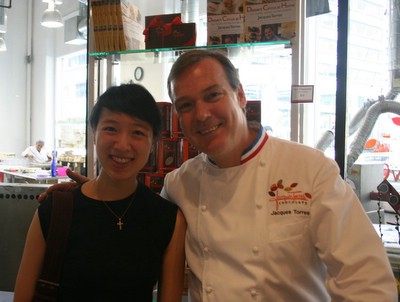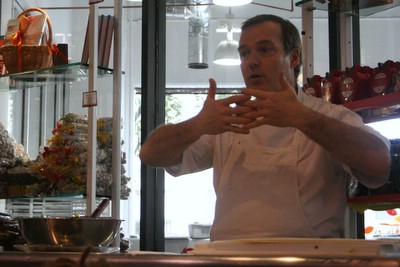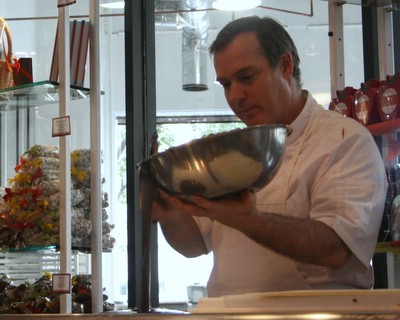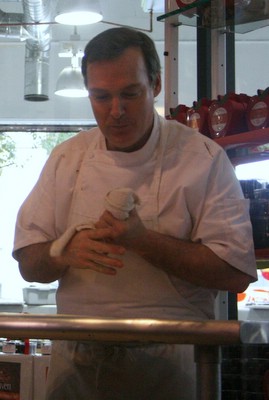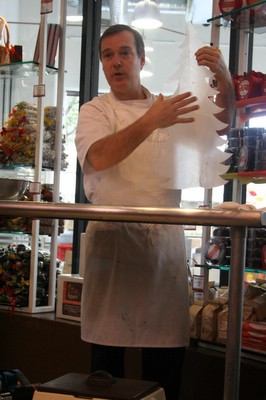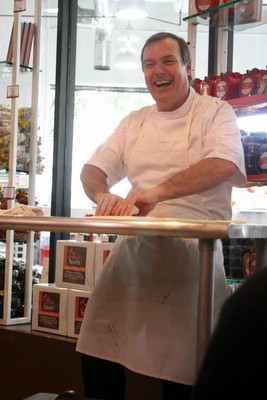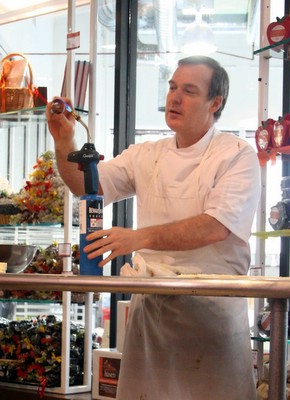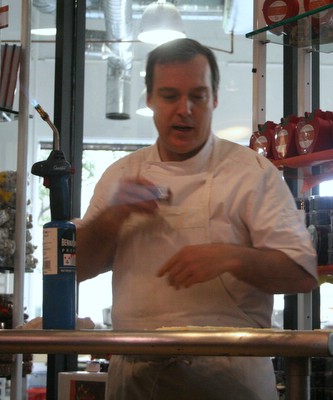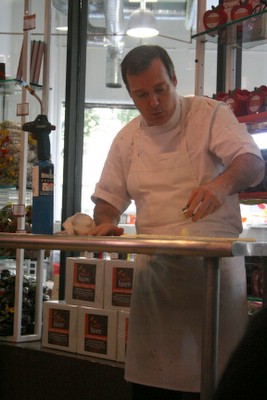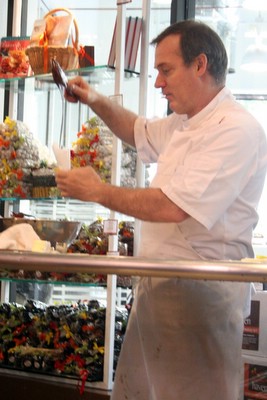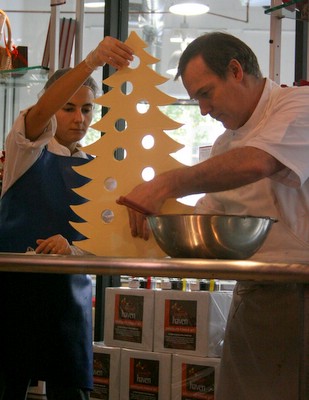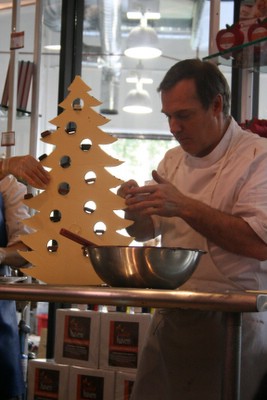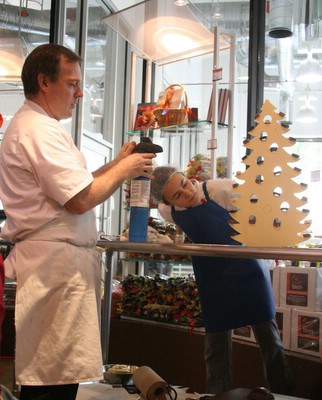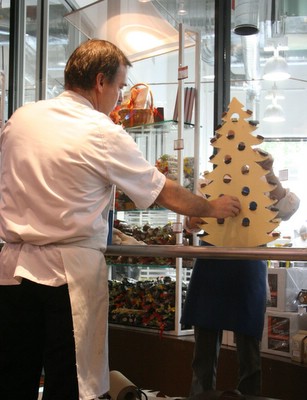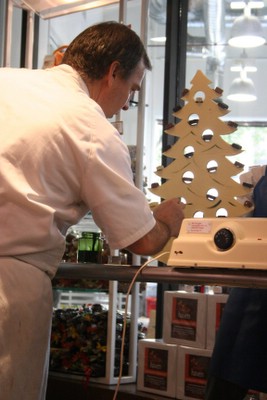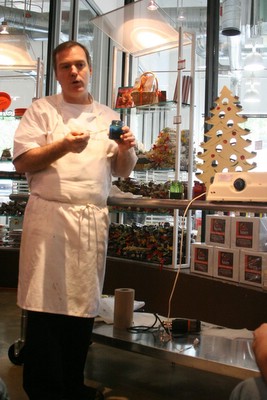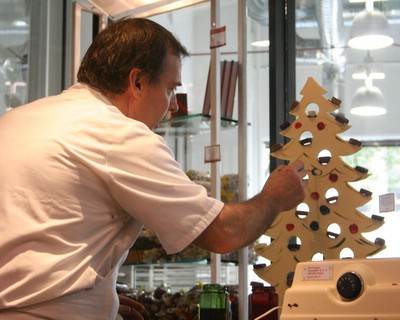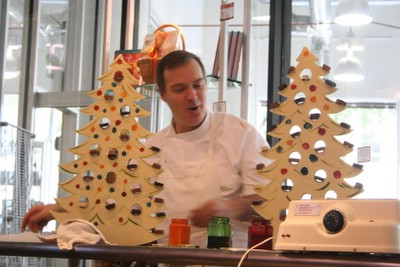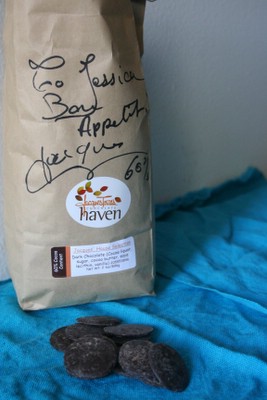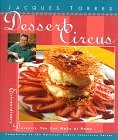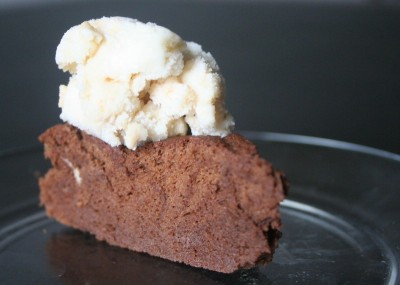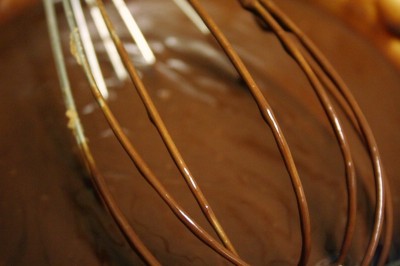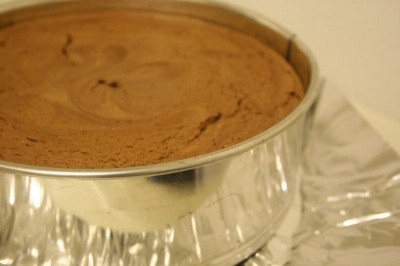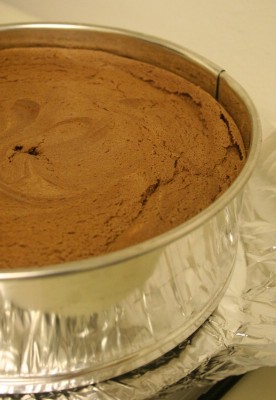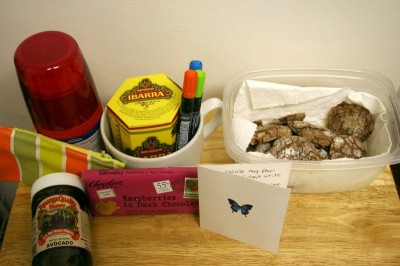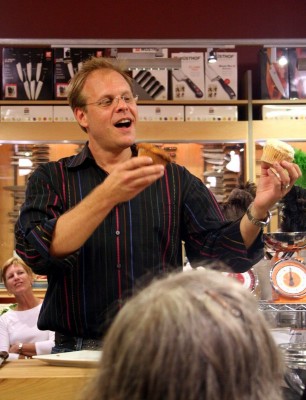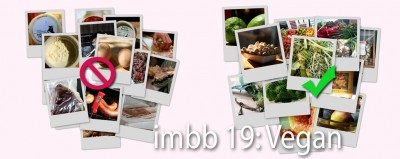
Traditionally, cookie swap parties are held shortly before Christmas and allow people to sample a plethora of cookies. Each participant brings several batches of their favorite cookies and distributes them. The more people the better: you can potentially go home with 10 varieties! This month’s Is My Blog Burning, has the same concept, but it’s gone online. If you need holiday baking ideas, check out Jennifer (of The Domestic Goddess) and Alberto’s (of Il Forno) round-up.
I’ve decided to combine a bit of the old with a bit of the new. First is a chewy chocolate chip cookie that has been a family Christmas tradition for a decade. The second cookie is my signature macaroon, enrobed in chocolate.
As I’ve said before, chocolate chip cookies spurred my love for baking. When I was around 12, my mom and I whipped up a recipe that a co-worker had given her. It called for a half-half mixture of butter and vegetable shortening. Our kitchen was sparse and we didn’t have shortening. But we saw the word “vegetable” and figured we could substitute vegetable oil. (I still don’t use vegetable shortening for health, texture and taste reasons.) Because of the oil, the chocolate chips slipped of the dough, which we accepted.
At the time, we also didn’t own baking sheets, so we made our own by cutting up paper grocery bags. To place them in the oven, we slid them off a giant piece of cardboard, much like a cook uses a pizza peel. We didn’t know that cooling racks existed either, so we lined the stove with newspaper and laid the “cookie sheets” on top.
Despite these untraditional techniques, the cookies were delicious. Because they were made with 100% whole wheat flour, they were different from the traditional Toll House variety. But they were good in their own right: chewy, soft and satisfying. We’ve made these year after year for the holidays.
Below is the adapted version (I believe cookies should be 100% butter), and you can use a mixture of flours to lighten the texture (but I can’t tell you the ratio because I want to keep my secrets!).

Chewy Whole-Wheat Chocolate Chip Cookies
Makes 3 dozen cookies
1/2 c sugar
1/2 c brown sugar
1 stick butter, at room temperature
1 tsp baking soda
1 egg
1 tsp vanilla
1 1/2 c whole wheat flour
1/2 c chopped toasted nuts (optional)
1 c chocolate chips
Heat oven to 375° F. In a medium bowl, mix the sugars, butter, egg, and vanilla with a wooden spoon until smooth. In a separate bowl, stir the flour and baking soda. Add the flour mixture, chocolate chips and nuts to the wet ingredients. Drop by rounded teaspoons onto ungreased baking sheets.
Bake for 8-9 min, or just until edges begin to brown.
Notes:
I recommend these chocolate chips:
Whole Foods 365 Everyday Value-Outrageous semisweet flavor. At 1.99 for 12 oz., it’s actually cheaper than the brands below and better! It has only the real stuff: cocoa liquor, sugar, cocoa butter, vanilla and soy lecithin (an emulsifier). Chocolate manufacturers often cheat by substituting vegetable or milk fat and vanillin.
Nestle Toll House Semi-Sweet Morsels-classic semisweet flavor with a bit of an acidic edge (which I like). The chips soften after baking, so they melt right in your mouth when you bite into them.
Mrs. Fields-slightly more multi-faceted flavor than Nestle’s.
Ghirardelli Semi-Sweet Chocolate Chips-a dependable brand with a smoother flavor than Nestle’s. Despite the fancy name and packaging, they’re at the bottom of the “recommended” list.
Not recommended:
Hershey’s Semi-Sweet Chocolate Chips-flat flavor that resembles milk chocolate.
Guittard Semi-Sweet Chocolate Chips-they may make gourmet chocolate, but their chocolate chips aren’t as rich as Nestle’s.
Pathmark supermarket brand-an ideal ingredient list (cocoa liquor, sugar, cocoa butter, vanilla and soy lecithin) and cheap price attracted me to the product, but it was waxy and fake tasting.
Chocolate-Covered Macaroons

Although everyone loves chocolate chip cookies, the cookie that most people ask me to make is the French-style macaroon. While the American version consists of coconut and is often dry and mealy, the French version uses ground almonds and has a chewy bite underneath a crisp shell.
My only complaint is that macroons have a short shelf life. I can’t ship my them, lest someone wants to pay for overnight delivery. In my latest attempt to prolong the shelf life, I dipped my macaroons in chocolate (thanks to David Lebovitz’s blog for the idea!). I figured the chocolate would create a barrier to keep the cookies moist.
In my experiment, I ate one cookie a day and studied how the texture degraded over time. Sadly, the cookies still dried out after two days, but fresh chocolate-dipped macaroons are as decadent, if not more addictive, than truffles!
Adapted from Alice Medrich’s Cookies and Brownies
Makes 3 dozen sandwich cookies, about 1 1/2-inches wide
Ingredients
7 ounces blanched almonds (1 1/3 cups whole or 1 2/3 cups slivered)
1 1/2 cups sugar
3 to 4 large egg whites
A variety of jams, frosting, lemon curd, caramel sauce, Nutella, fudge sauce or ganache
12 oz. of dark chocolate (chocolate chips are not recommended, as they don’t melt as well)
Equipment
2 cookie sheets, greased, or lined with parchment paper
In a food processor with a steel blade, process the almonds and sugar until the almonds are very fine and the mixture begins to pack together around the sides of the bowl, at least 3 minutes. With the processor on, slowly drizzle only enough of the egg white to form a ball of dough around the blade. Keep the processor on. Add only enough additional egg white so the dough has the consistency of very thick, sticky mashed potatoes and no longer forms a ball.
Pipe or drop rounded teaspoons (equivalent to 2 level teaspoons) 2 inches apart on the cookie sheets. Gently press down on the top of each cookie to smooth it out. Let the cookies stand for 30 minutes .
Preheat the oven to 300° F. Position the racks in the upper and lower thirds of the oven. Bake for 20 to 25 minutes, or until the edges of the cookies barely begin to color. Rotate the pans from front to back and top to bottom about halfway through the baking time to ensure even baking. Slide the parchment onto racks. Cool the cookies completely before detaching them.
Spread the filling on the flat side of half of the cookies and top with the remaining cookies.
Drop the cookies into melted tempered chocolate. Couverture, or covering chocolate, is easiest to use because the extra cocoa butter makes the chocolate more fluid. It’s NOT confectionery or compound chocolate, which has vegetable fat and is not as rich. One way to temper is to melt 3/4 of the chocolate (9 oz. in this case) on top of a double boiler and add in small pieces of the reserved chocolate until the mixture registers 88° F on an instant-read thermometer. Use an immersion blender to smooth the mixture and circulate the good crystals. Tempering is done so that the final product has a good gloss and snap. To test the temper, spread some chocolate on the tip of a knife—it should set up within a minute.
If you plan on consuming the cookies right away or don’t mind occasional white streaks in the coating, simply drop the cookies into melted chocolate.
Roll the cookies around until all sides are coated with chocolate, and fish them out with a fork. Place on wax or parchment paper to harden. Consume within two days.
If you have leftover chocolate, grab everything in your cupboard and start dipping! Or, mix with milk to make hot chocolate. Or, pour it onto parchment paper to harden and use for another time.

